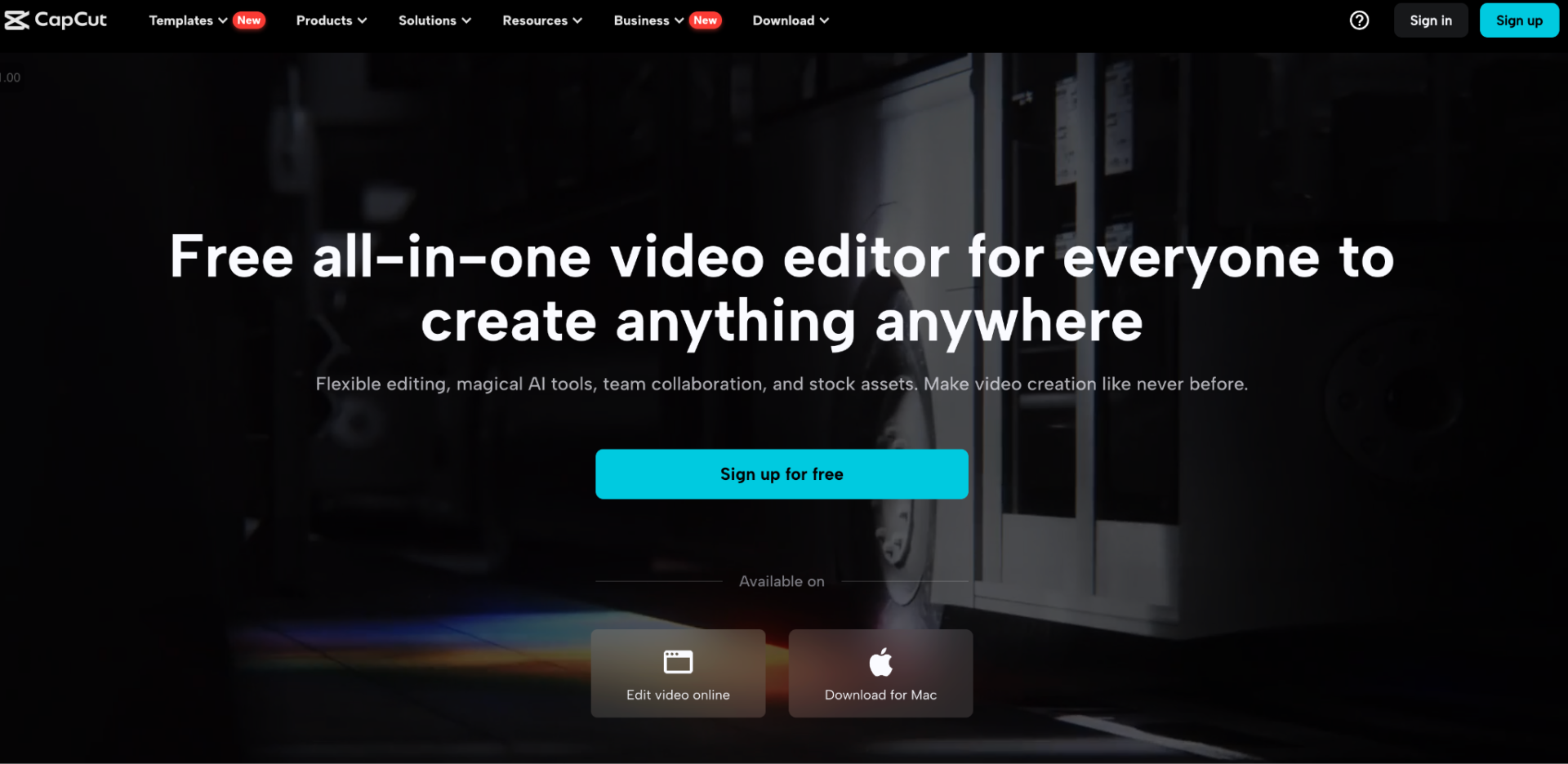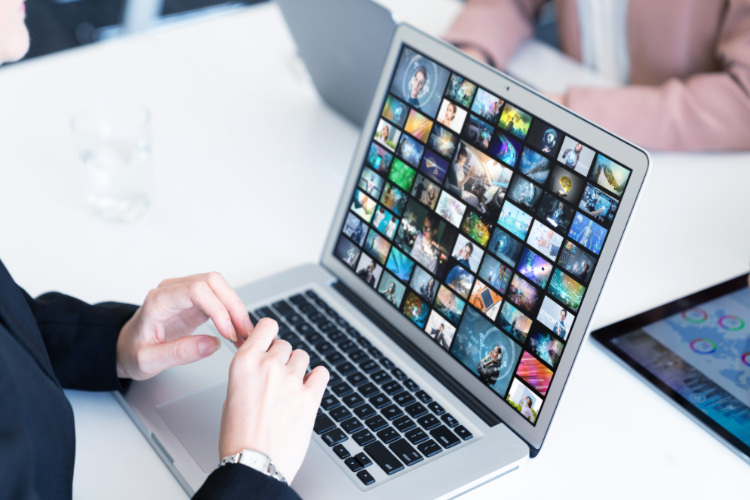How to Create YouTube Videos Using AI (2024 Guide)
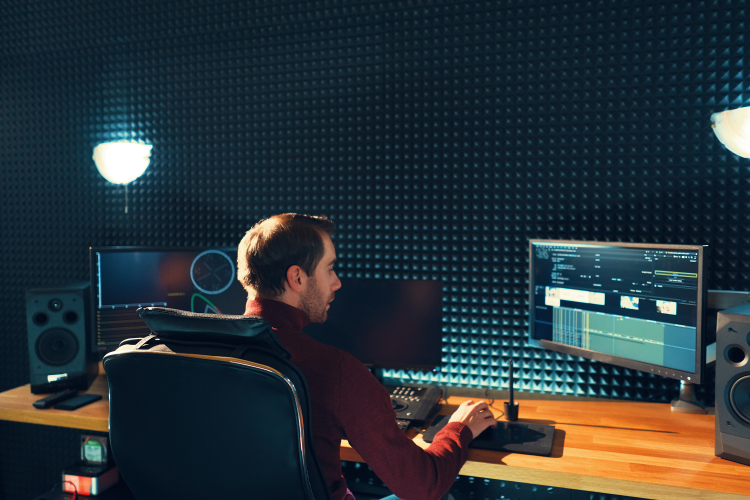
Jordan is a “wannabe video creator” going through a tough time. He’s tried to learn video creation, editing, and publishing – but he can’t keep up with the complex processes. He’s close to giving up.
One day, he’s sitting in front of his computer, pulling his hair out in frustration. He sees an ad about the latest video platform and (out of desperation) clicks on it.
A video AI chatbot starts a conversation. The chatbot asks Jordan to input a video idea and promises to generate a complete video.
Jordan stops and wonders, “Are you saying that if I give you a rough idea, you’ll turn it into a video I can use? Just like magic?’
The video chatbot magically replies, “Exactly, Jordan. I do the hard stuff without much guidance. You just make some final changes and get a great video to upload on YouTube.”
This makes Jordan think:
- Can he use AI for YouTube script generation?
- Is the technology reliable?
- Will the videos be high quality?
- And most importantly, will he FINALLY figure out how to make YouTube work (and monetize his content)?
In this post, I show you how to create YouTube videos using AI. I also share the tools I use at the different video creation stages.
I created this guide based on my experience building a YouTube channel with 175,000+ subscribers. The result? You’ll get all the tips and tricks I learned along the way – without the painful lessons.
How Do You Create YouTube Videos Using AI?
Here are the steps to create YouTube videos using AI.
In this section, I cover two of the most popular AI video platforms: InVideo and Lumen5.
Using InVideo
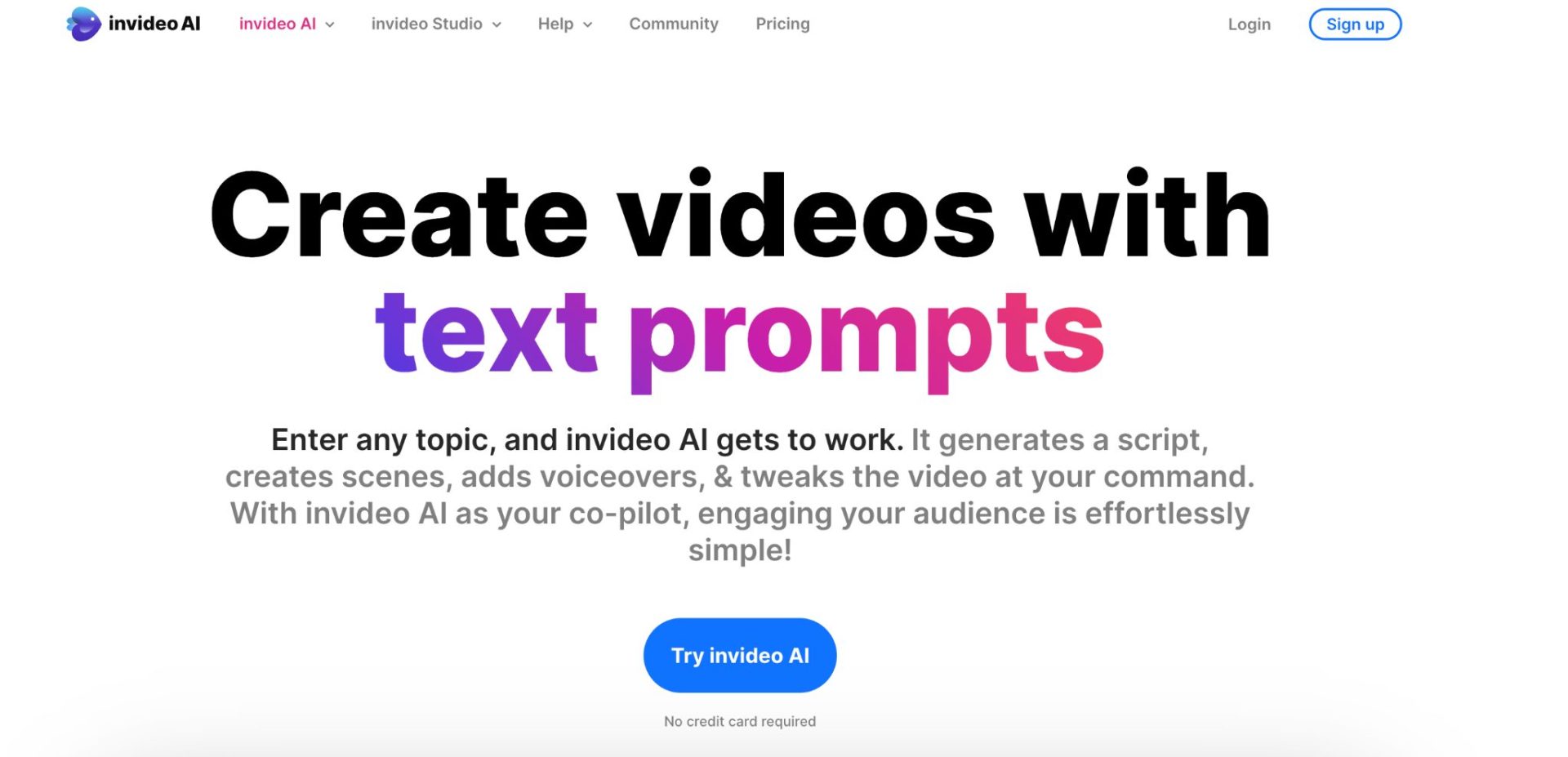
InVideo is one of the best AI video maker tools. The software is easy to use with virtually no learning curve.
Steps to AI video creation
Here are the steps involved:
- Start with InVideo: In the video platform, choose the option to create an AI video.
- Enter Topic or Instructions: Use natural language to describe the type of video you want. I’m going with blogging challenges in 2024 for this example.

- Voice Cloning Option (Optional): You can choose to clone your voice for the video. This optional step depends on your preference for personalization. It could be useful if you’re creating lots of videos without wanting to record a voiceover for them.
- Choose a Workflow (Optional): You can also choose a workflow rather than starting from scratch. InVideo offers workflows that include YouTube explainers, YouTube shorts, TikTok videos, Instagram reels, and more.
- Choose your options: Once the wizard starts processing, choose who your video is for. Is your target audience content creators, bloggers, or enthusiasts? You can also decide on the video’s aesthetic. Do you want a minimalist, modern, professional, or inspiring video? Finally, select the final destination for your video. This can be YouTube or Facebook.
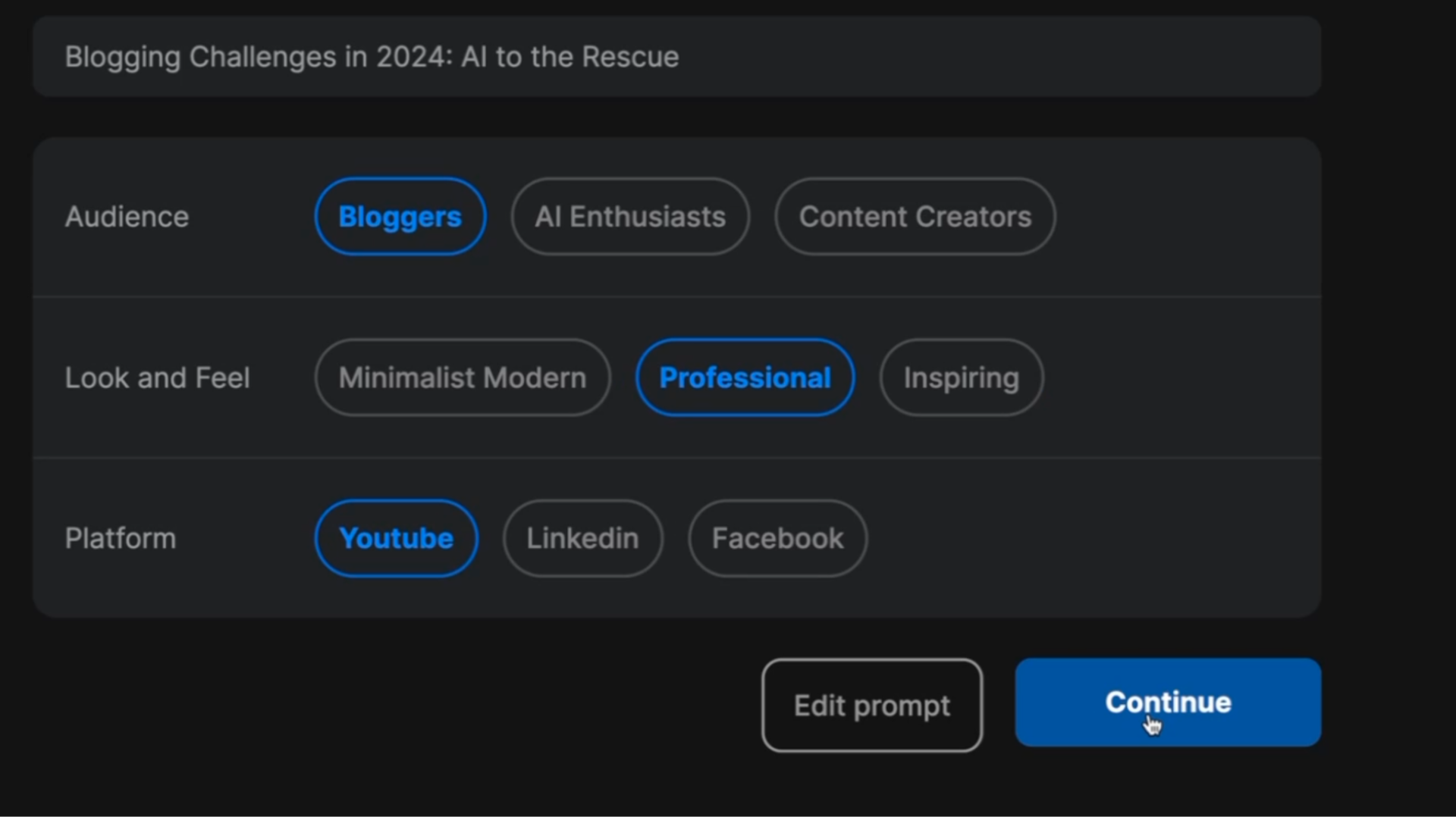
- Wait for the AI to Generate the Video: Next, the AI will analyze your selections and start creating the video.
- Review and Edit the AI-Generated Video: Once the tool finishes creating the video, you can make adjustments. If the video doesn’t match your expectations, you can edit it by providing another prompt. For example, I asked the tool to cut the video length in half. You can also do this manually by editing the script, modifying the scene lengths or even selecting assets from the stock library.
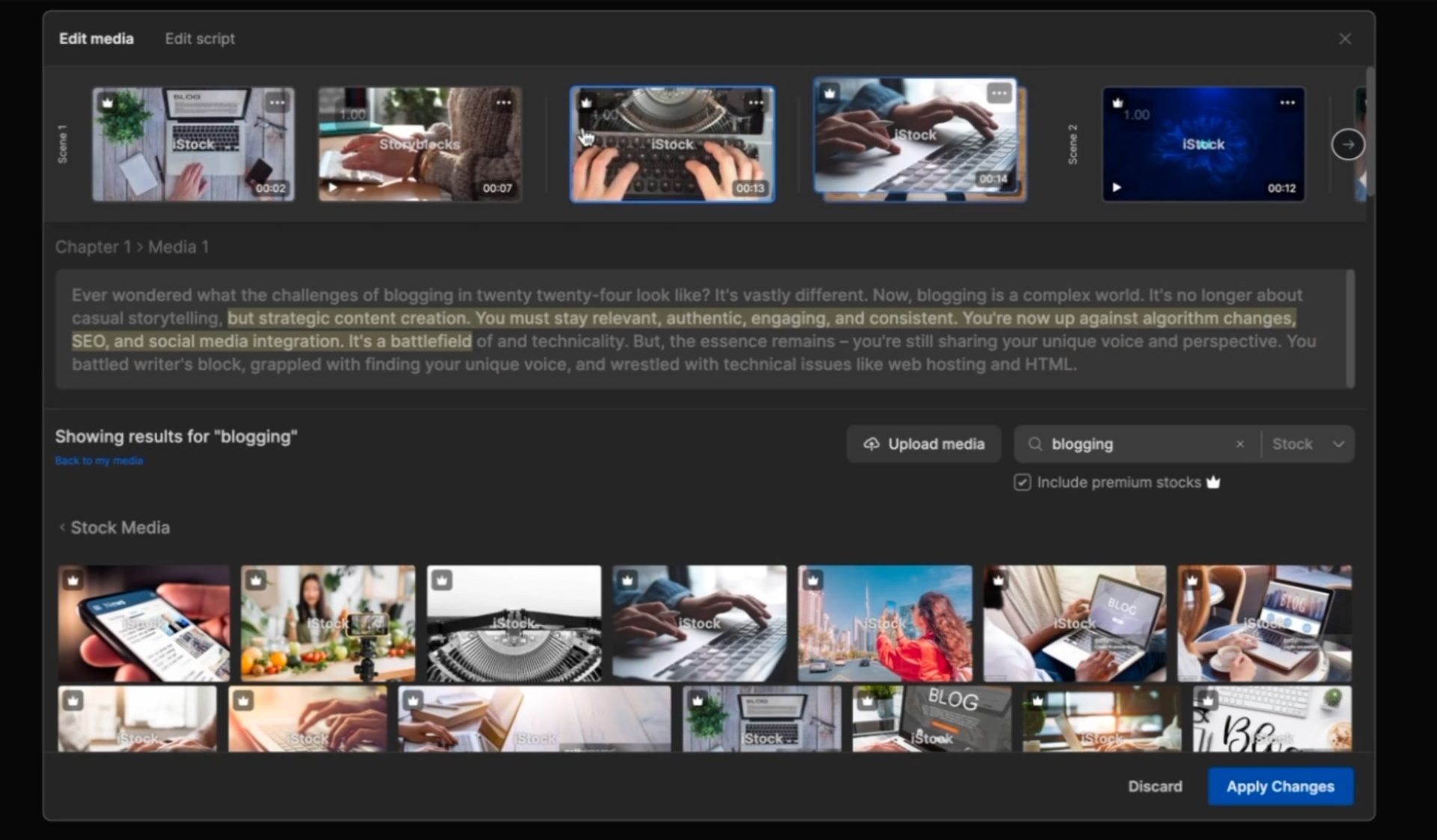
- Download Your Video: Once you’re happy with the output, you can download the video. The free version comes with a watermark. You’ll need to upgrade your plan to remove it.
- Final Adjustments (Optional): InVideo also offers a version history option. You can revert to a previous video version if needed.
Key Features:
- AI-Powered Video Generation: InVideo allows users to create videos based on natural language prompts. There’s no need for complex editing – unless desired.
- Voice Cloning Option: Users can use AI to build a version of their voice and use it in the videos.
- Workflow Support: Different workflows help you create better videos. Workflows for YouTube, TikTok and Instagram are all supported.
- Customization Options: It’s easy to choose the look and feel of your video.
- Editing Capabilities: After InVideo creates a video draft, it’s easy to edit it using natural language prompts. While these edits take the longest (compared to doing edits manually), they work relatively well.
Strengths:
- Versatility: InVideo is a versatile tool capable of creating videos for a wide range of social media platforms.
- Ease of Use: The video creation and editing process is straightforward. There isn’t a learning curve involved. InVideo uses AI to allow users to create videos without advanced skills.
Weaknesses:
- Limited Control: Users have limited control over the final output. I couldn’t add new elements within the generated videos. Instead, I could only replace existing ones.
- Watermarks in Free Version: Videos created with the free version have watermarks.
- Potential AI Misunderstandings: The AI may misinterpret instructions given in the creation and editing stages. You might need further refinement to get the desired video.
InVideo AI is ideal for bloggers, content creators, and social media enthusiasts. Anyone looking to create videos (without getting into video creation complexity) can benefit from this tool.
This platform helps create engaging content. This helps brands stay relevant, authentic, and consistent.
Using Lumen5
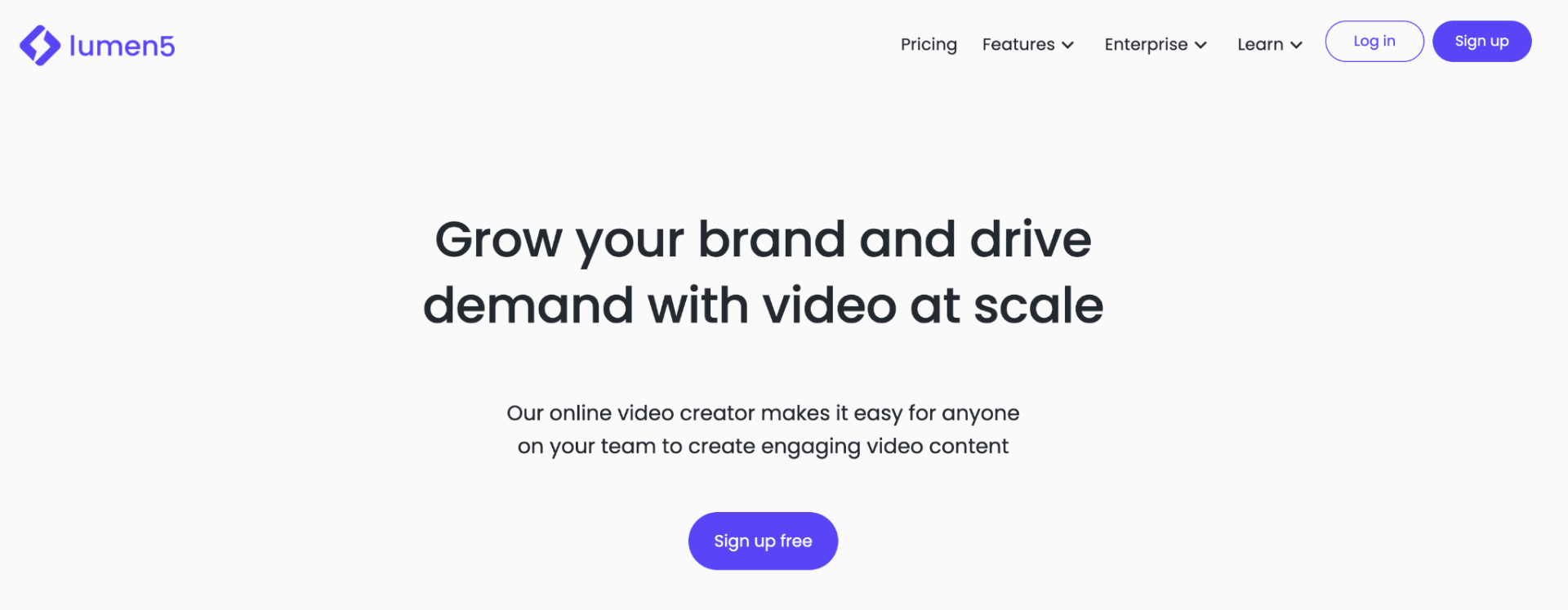
Lumen5 is one of InVideo’s direct competitors and another tool you can use to create AI videos for your YouTube channel.
One thing I like about Lumen5 is its ability to generate video content as soon as you publish content on your blog. By analyzing your blog feed, it will “know” when you publish new blog posts.
It then turns these posts into video content automatically.
Steps to creating AI videos using Lumen5
Here’s how to create videos using Lumen’s 5 AI video maker:
- Sign Up/Login: First, sign into the platform.
- Select Instant Videos: You can set up your blog feed to notify Lumen5 when you publish new content. In this case, go to the “Instant Videos” section to set it all up.
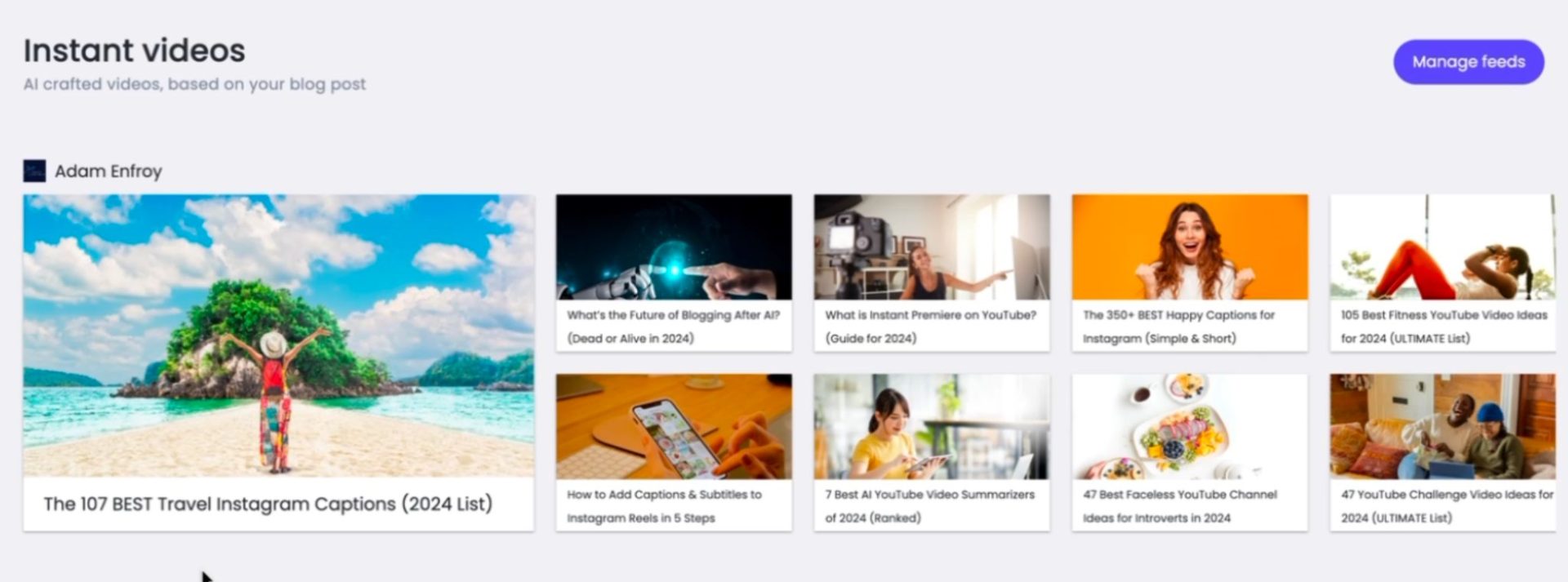
- Input Blog Post URL: Input any blog post URL and Lumen5 will start analyzing all the posts you have on your blog.
- Choose a Video Template: After adding your blog post, choose the template you’ll use to start creating your first video. Ideally, you’ll want to choose something that suits the tone and style of your brand.
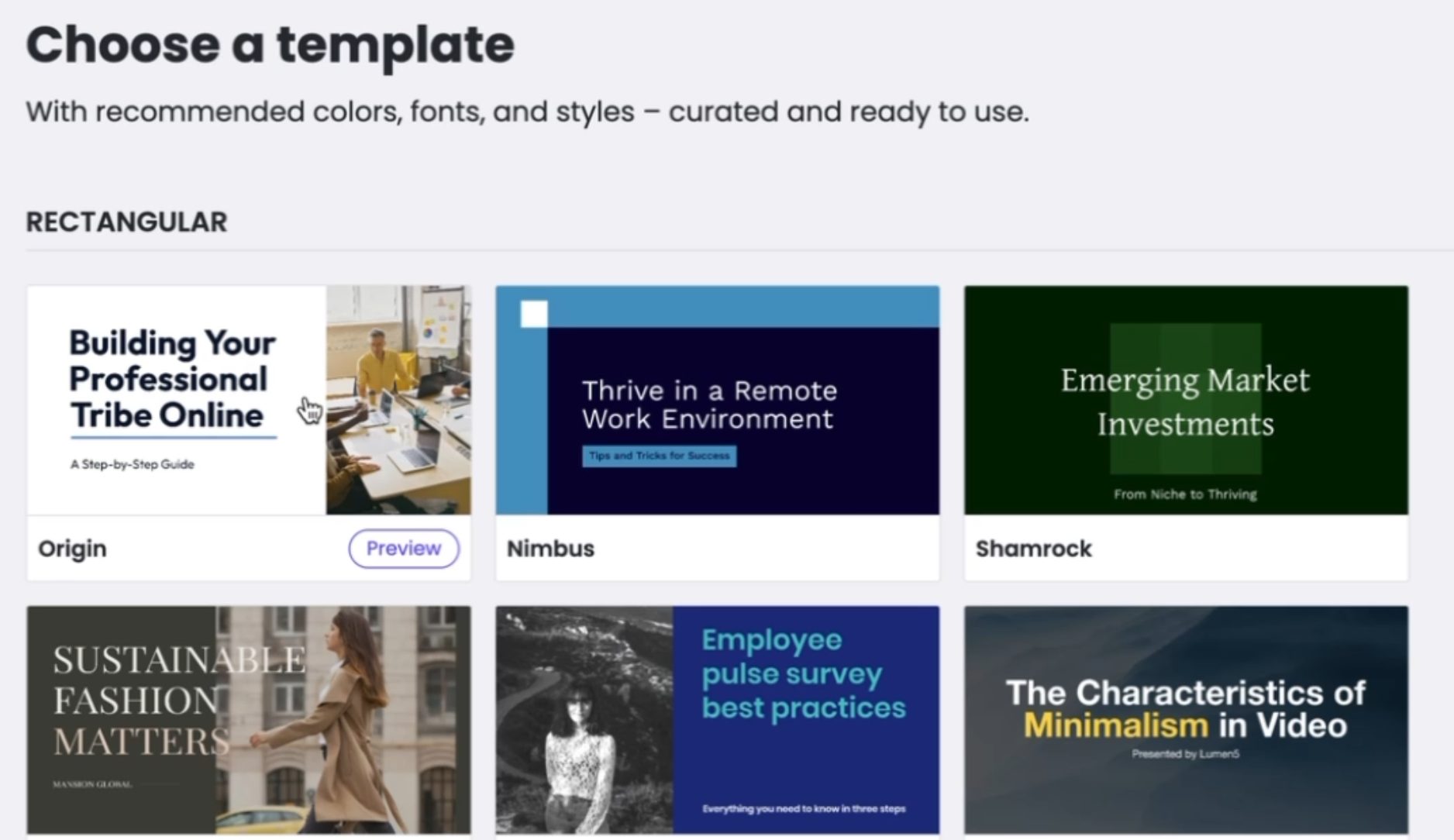
- Compose Script: Within the “instant videos” mode, the tool uses your blog posts as the video script source. You can also edit the script if you prefer more manual control.
- Wait for the AI to Generate the Video: Lumen5 will create the video based on your input.
- Customize Video: You’ll then review the generated video and make any needed modifications.
- Add Voiceover (Optional): Lumen5 asks you to add your own voiceover. There didn’t seem to be an option to use an AI voice clone when using “Instant video”.
You can also follow a similar process to create one-off videos. These are the videos not generated from your blog’s feed. With this “one-off” mode, you can use Lumen5’s built-in AI voices to generate voiceovers.
Key Features:
- Instant video creation from blog posts: You can generate videos as soon as you publish new posts on your blog. This is great for bloggers who want to make the most of the content they publish.
- Automatic scene creation: Lumen5 will divide your blog post into different scenes. Using your blog post layout generally translates into a well-structured video.
- AI-generated voice overs/uploading custom voice overs: You can choose between having an AI-based voiceover or uploading your own audio file.
- Customization: You can easily edit video elements. Edits include music volume, media volume, and design.
Strengths:
- Fast and efficient video creation process: There’s no need to spend hours testing things before creating videos. Lumen5 is straightforward to understand and easier to use.
- AI voice overs come included: There’s a lot of AI voice overs that come with the platform.
- Recycling content: Lumen5 is excellent for generating video content from existing blog posts. There’s no need for manual scripting or doing additional work.
Weaknesses:
- Limited control: The instant video feature doesn’t allow many changes to a video draft.
- No option to create/edit videos using natural language: Unlike InVideo, you have to manually create and edit videos. You cannot “chat” with the platform to get the desired results.
- Editing is not super-intuitive: The editing part of the video process is not so intuitive. I might even say it’s pretty limited.
Best Practices for Creating High-Quality AI YouTube Videos
Video content creation has become pretty easy to get into.
However, creating videos that get your message across requires following best practices. You have to consider your chosen AI tools and their strengths and weaknesses.
Moreover, you can’t expect AI to do all the work – similar to AI writing tools. If this were the case, there would be no need for the ‘human’ (i.e., you) in the process.
Here are some fundamentals when creating AI YouTube videos, whether converting blog posts into AI videos or starting from scratch.
Concept and Script
With most AI video tools, you can ‘chat’ with the platform. The aim is to provide the necessary information about what you want in your video. Then, AI will use its ‘best judgment’ to develop a script based on your prompt.
There are a couple of essential concepts here.
First, your prompt matters.
The more detail you put into it, the better the output. If you give unclear instructions at this first stage, the final results probably won’t be what you’re expecting.
Moreover, consider that outlining your ideas is crucial. If you know what sections you want in your videos, provide these when prompting the AI.
Next, you should refine your message with each generation. You probably won’t get the final version of your YouTube video based on the first draft the AI generates.
Instead, think about it as an iterative process. Each step brings you closer to the final result.
Storytelling
Videos are an excellent medium for telling narratives that hook your audience. Ideally, your videos should also keep your audience on the edge of their seats throughout the video.
Knowing what your storyline will be comes first. Then, you can guide the AI to create the right video. As with the previous step, you can’t expect AI to do all this alone.
Instead, consider these questions as you develop your story:
- what are the pain points your audience is going through?
- how can you use these as hooks
- how do you let viewers know it’s in their interest to watch your video from start to finish (without explicitly telling them)?
AI video tools work well with visuals, transitions, and music selection. However, creating an engaging flow (from the first to the last second) is something you’re responsible for.
Target Audience
Let the AI know if you have a specific persona that will probably watch your video (based on your regular YouTube audience).
Providing this information helps the AI generate a more tailored video.
As you’re editing the video, you also should keep your audience in mind.
The messaging, tone, and voice of your video should consider the people that will consume it. If the video doesn’t do this, people will likely lose interest and quickly drop off.
Quality
AI can do a lot in terms of quality. It can generate high-quality videos, choose suitable images and B-roll footage and even create natural-sounding AI voiceovers.
The progress AI tools have made in just a few short years is nothing short of breathtaking.
However, it’s still up to you to ensure your video hits the necessary standards. You can’t just throw up a video together, hit export, and expect it to succeed.
For starters, consider your brand identity. Is the generated video consistent with your brand’s messaging and aesthetics?
Are the images hyper-relevant? If not, you should change them.
Would you have picked similar images if you had manually gone through the video creation process? Again, if the answer is negative, replacing them with something better will pay off in the long term.
Overall, the human touch is still crucial to creating high-quality videos for your personal or professional brand.
Best Tools for AI YouTube Videos
In the previous section, I mentioned quite a few factors to consider. The good news is that there are AI tools to help with each stage.
If you find the tools mentioned above don’t cover all the bases (or just want a different perspective into other tools), here are some of the best ones to help.
Script creation
What you (or an AI voice clone) say in the video is half the battle to creating excellent videos.
Here are the tools I recommend to generate the best video scripts.
Jasper

Jasper has built-in templates to help with script creation.
The platform offers templates like:
- video topic ideas
- video script outline
- video titles
- video script gooks for YouTube
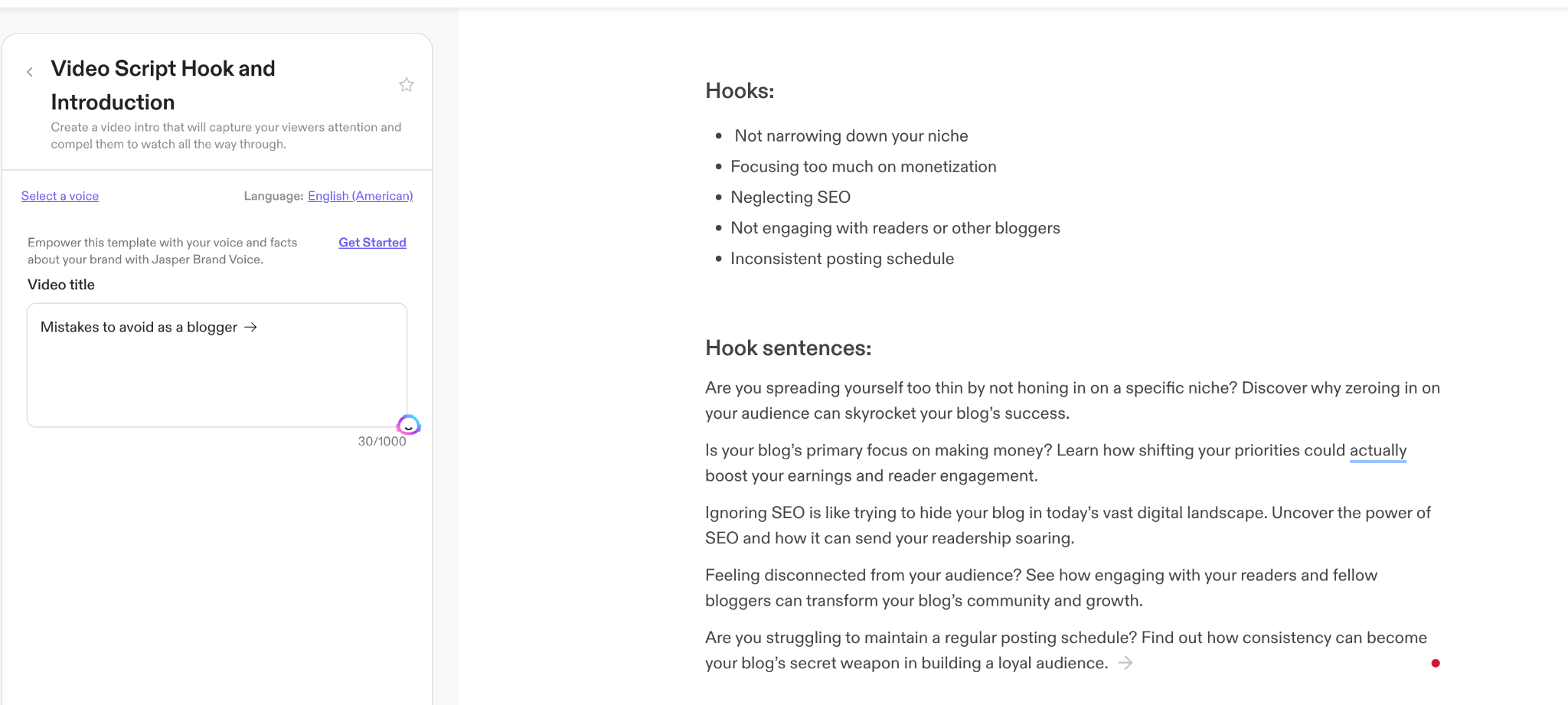
ChatGPT
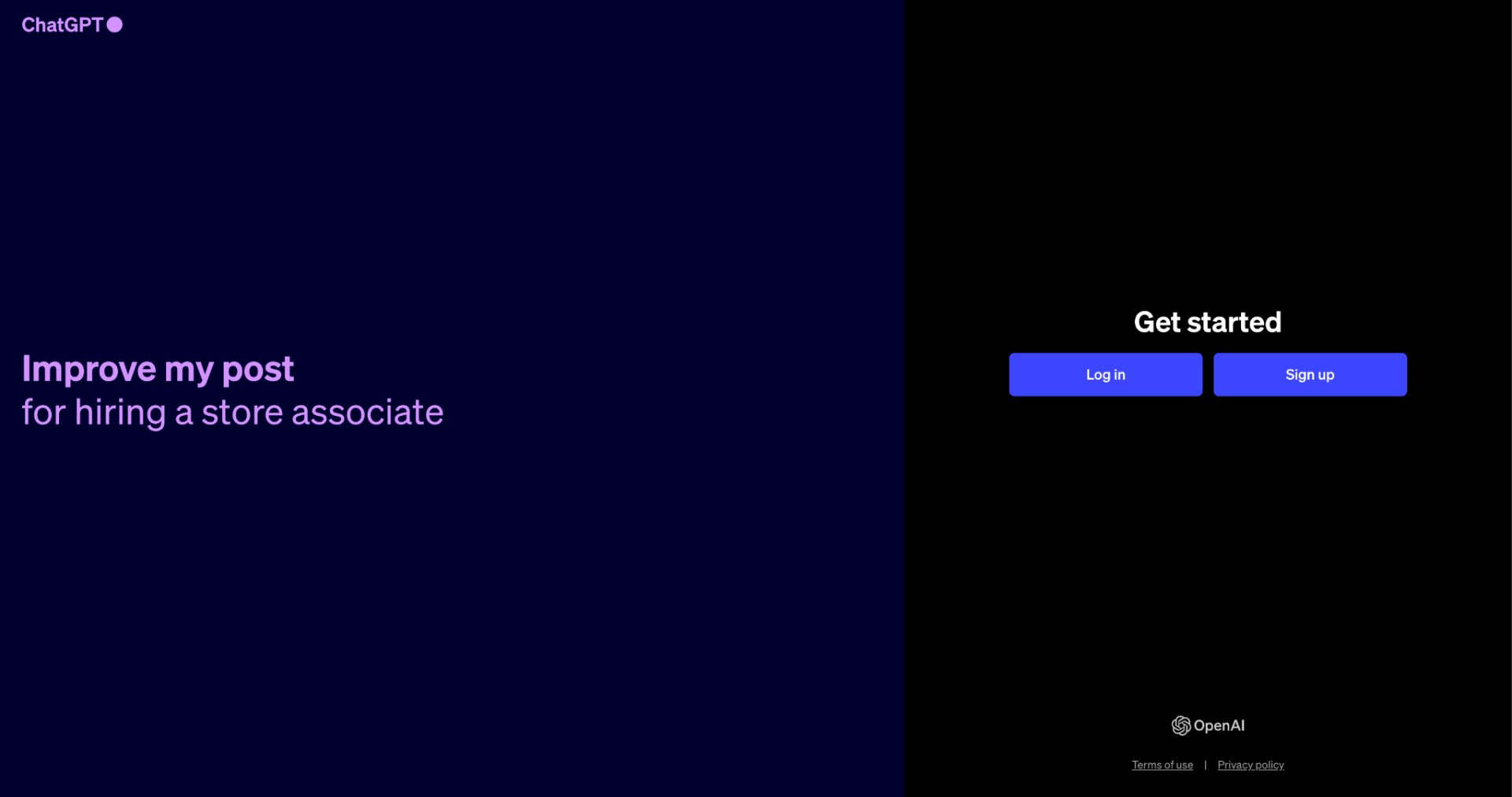
ChatGPT is a great AI text and image generator that packs so many useful features. However, it’s still as good as the prompts you give it. The better prompts you provide, the better the output.
One great feature I like about ChatGPT is that it can browse the web. If your videos require external sources, you won’t have to leave the ChatGPT window to have a complete YouTube video script.
Want more AI text tools? Check out my list of favorite tools for a complete breakdown of other great tools.
Voices
Many AI video creation tools have their in-built list of AI voices. Sometimes, these voices sound natural. Other times, it’s clear the voices are AI-generated and don’t sound professional.
Sometimes, your best bet is to use human-generated voice overs.
However, when this isn’t possible, here is a list of tools to generate great-sounding voices.
Elevenlabs
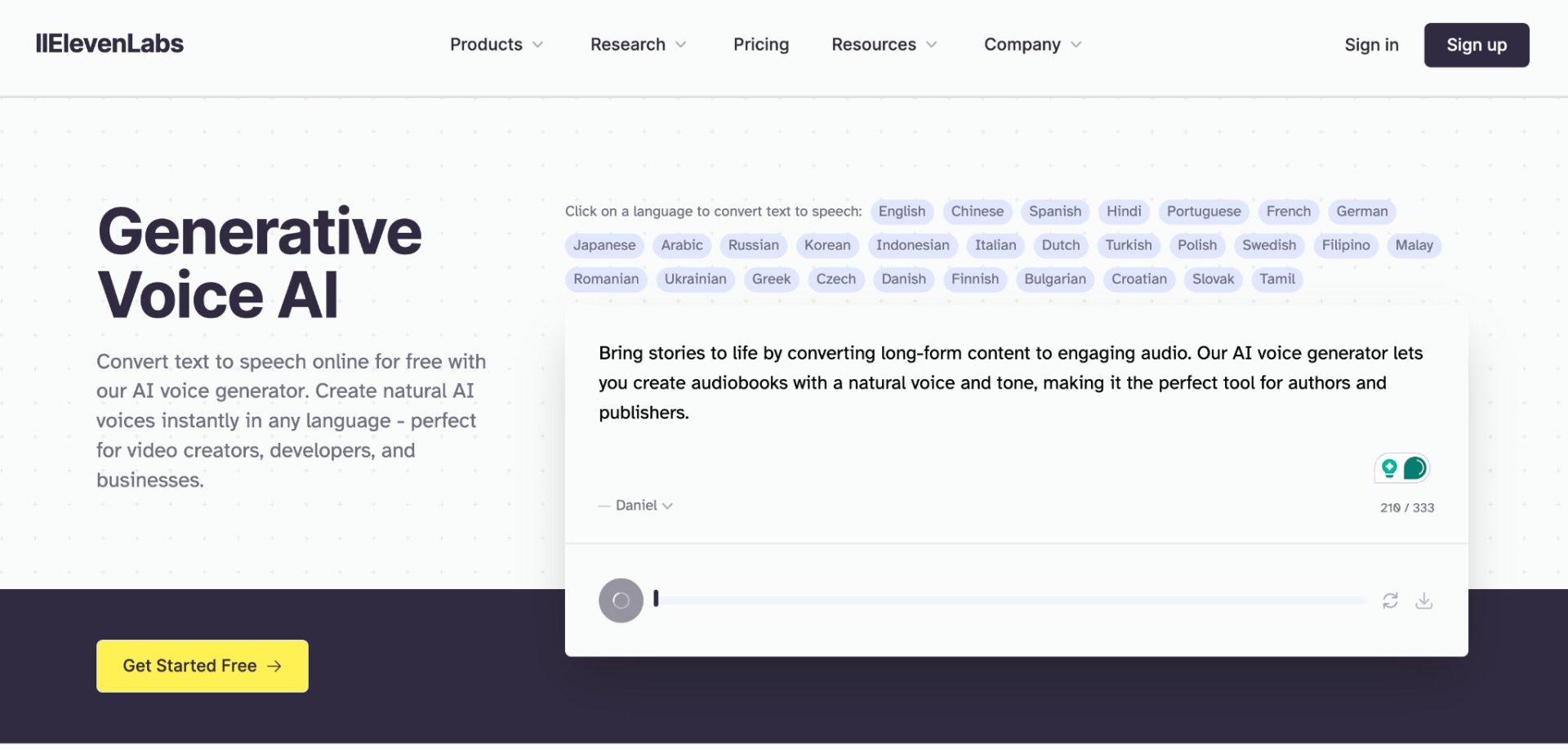
Elevenlabs provides some of the world’s most advanced AI clone voices. They promise natural AI voices that are instantly generated in any language.
Whether you’re a creator, business owner, developer (or somewhere in between) these voices can have a significant impact on your published videos.
Creating great-sounding AI voices involves:
- signing up for an account
- pasting in your text and
- waiting for the system to generate the audio file.
That’s all there is to it.
You can even preview what your AI voice will sound like on their homepage – without needing to sign up.
Here’s a great resource for more about AI voice cloning.
Image generation
Here’s a list of AI image generators to help you create the exact images you want.
Adobe Firefly
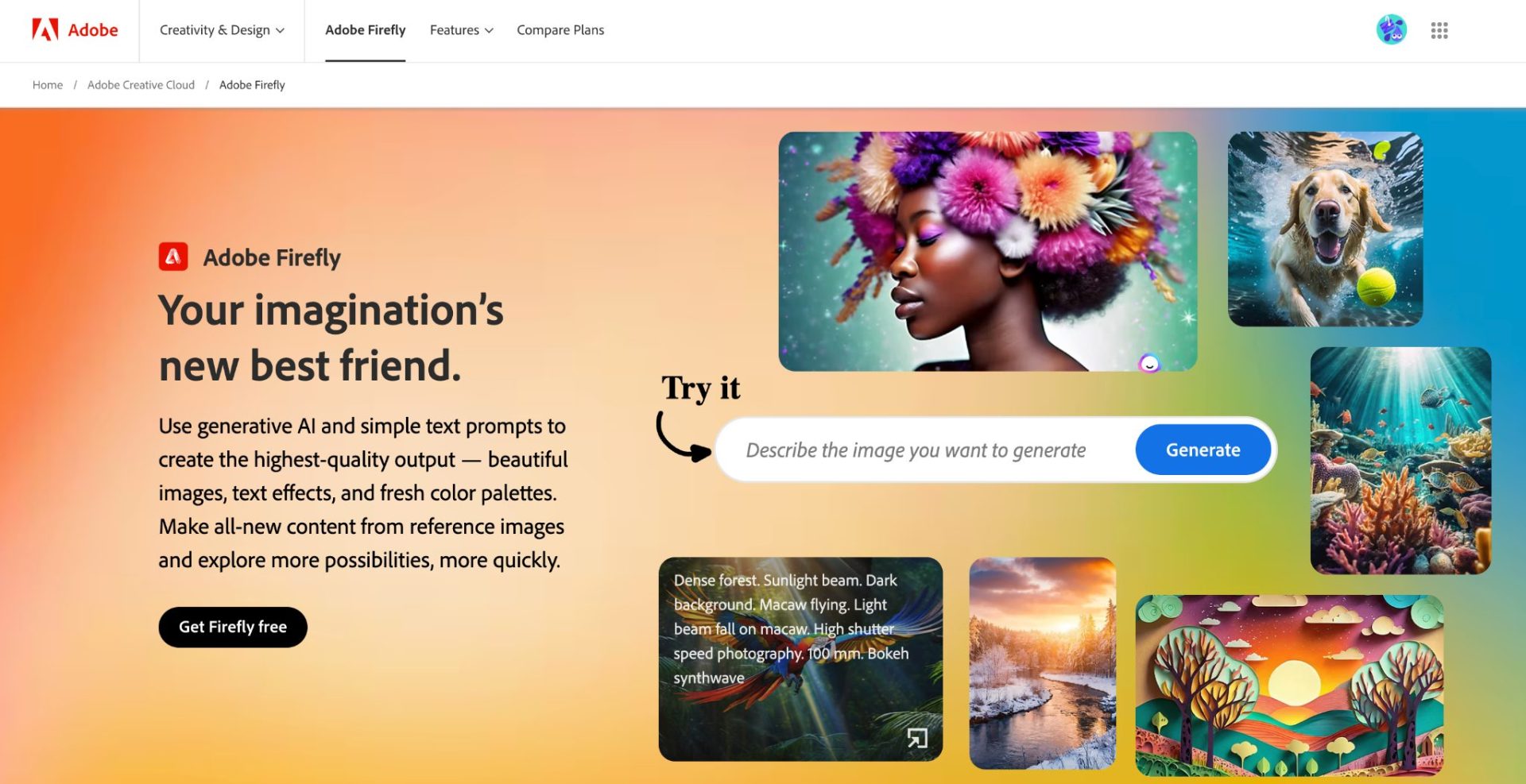
Adobe Firefly provides some of the most realistic images in the AI world.
Users simply input a prompt, wait a few seconds, and get multiple output options.
Adobe Firefly allows users to remove and add items from an image using natural language prompting.
These options are great when you need specific images for your AI generated videos. You also don’t need to know anything advanced about graphic software to get the job done.
Other AI image generators you can check out include:
Video creation
I’ve already spoken about InVideo and Lumen5 above. However, here’s another great tool to consider.
Synthesia

However, a software that’s worth mentioning is Synthesia. This platform is one of the best for avatar-based videos.
There are various AI presenters to choose from. These avatars also have lip-sync capabilities, meaning they can accurately mimic human speech.
This feature makes videos more professional and engaging.
You can also customize your avatars based on your branding elements. It’s like having an artificially generated speaker for your brand. This speaker can create as many videos as needed – without taking any time off (or get paid an hourly rate).
Video editing
I can’t write an article about AI video generation without mentioning a couple of tools you can use to edit your videos using the power of AI.
To recap, many AI video editors will have their own editors within the platform.
However, if you find these editors lacking, you might want to consider third-party options to get the job done.
Capcut
If I need to edit one-off videos, Capcut is one of my favorite tools.
The amount of updates this software gets (and how far it’s come over the last several months) is a lot.
You can use their AI tools to:
- remove background noises and unwanted silences
- add auto subtitles
- create short videos from a longer clip
- and much more.
Capcut is a great tool to consider if you need a third-party AI video editor.
Wisecut
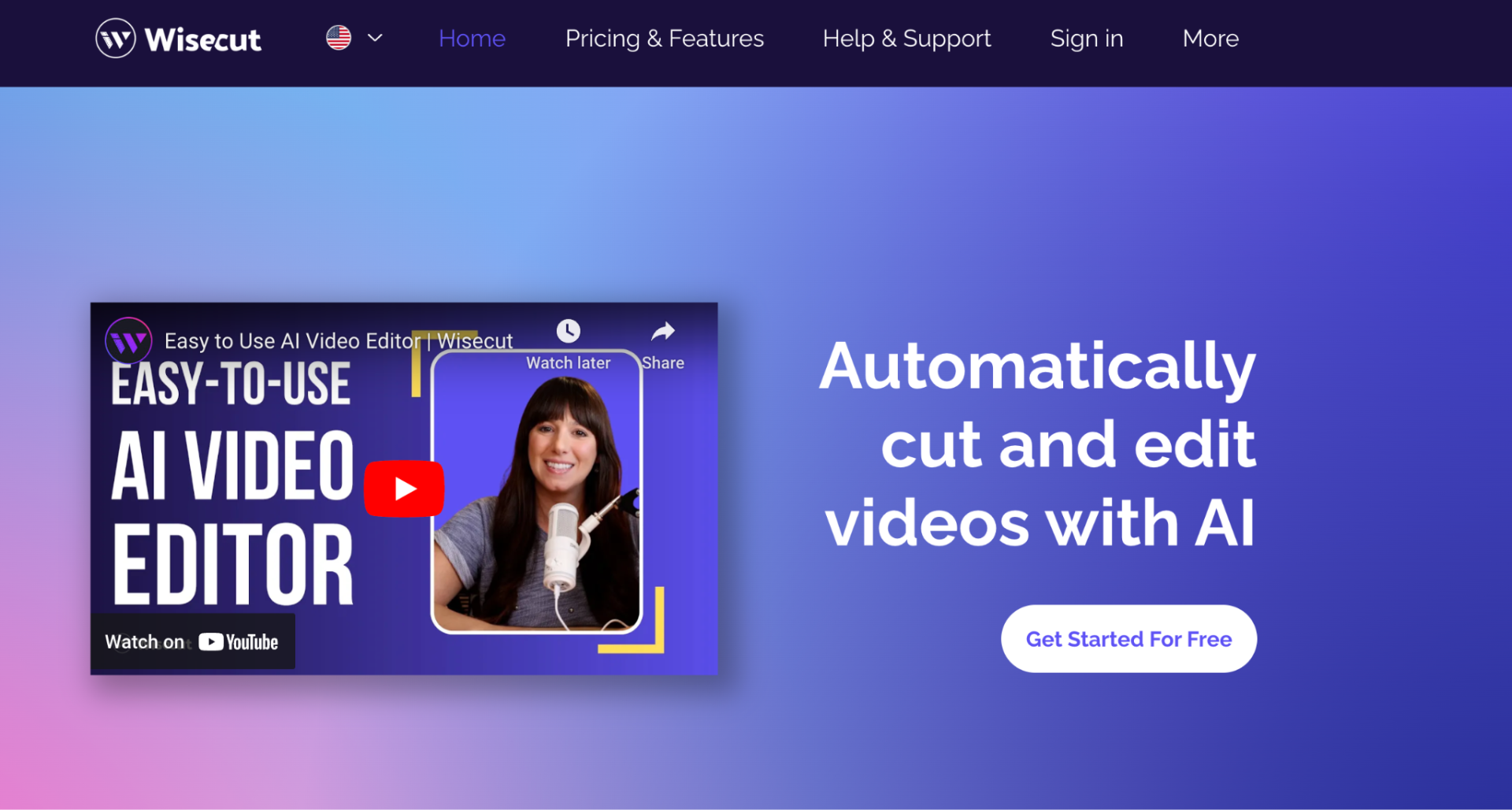
Wisecut promises to help you “cut and edit videos with AI”. You can leverage the power of AI to eliminate silences, automatically generate subtitles, choose the ideal background music, and more.
You can also do your video editing through storyboards.
This is a great way to get the desired output without getting lost in the details.
Wisecut | Storyboard-based video editing
Creating short-form video content
YouTube shorts, Instagram reels, and TikTok videos fall under “short videos”.
While some content creators love filming several of these short videos at one go, others hate it.
The latter would rather use content they’ve already created to develop shorter variations of their content.
If you’re part of this last group, here are some great tools to use.
Opus.pro
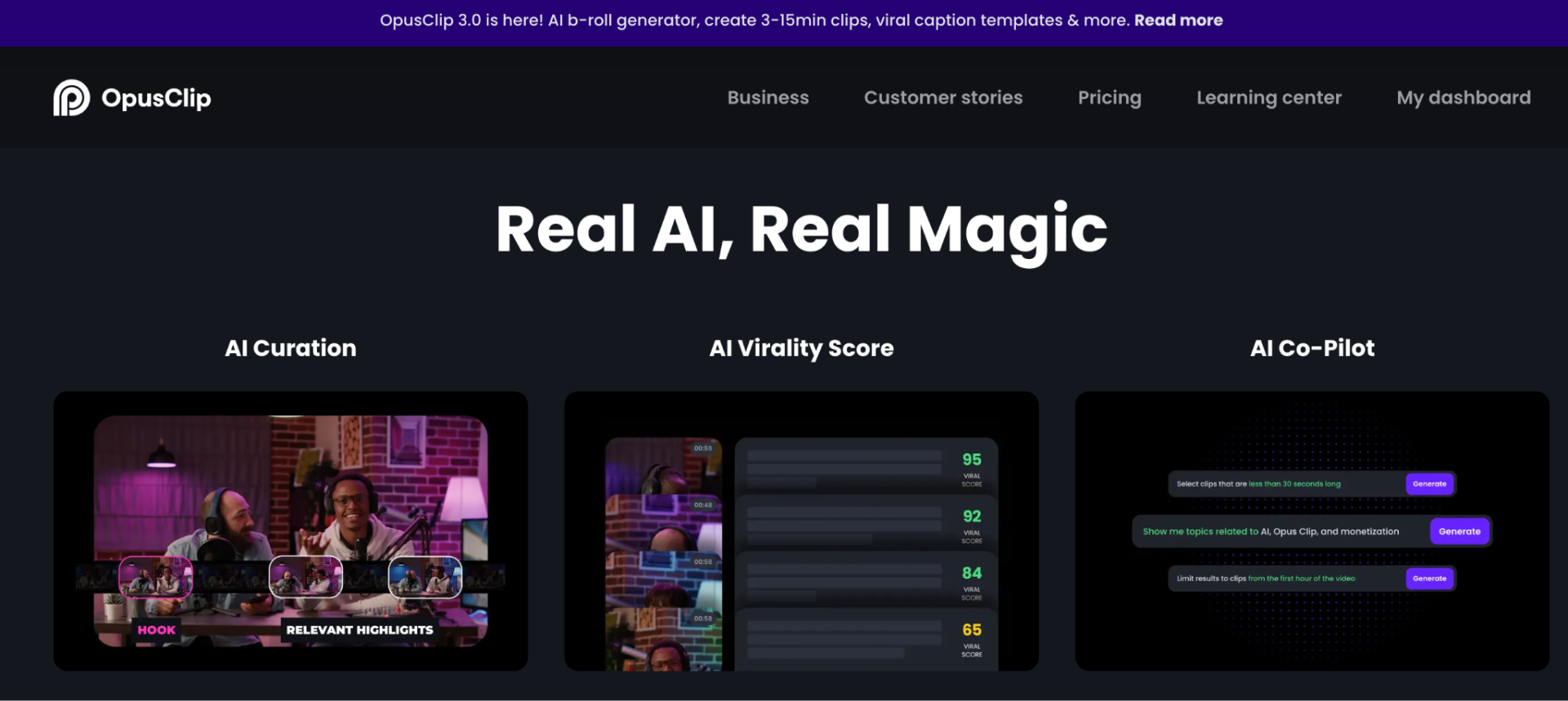
Opus.pro is one of the original tools video creators had to create short-form content.
It offers:
- AI video curation (choosing the best ‘short moments’ from longer video clips)
- AI virality score (telling you what the odds are of a clip going viral)
- AI co-pilot (giving you the ability to ‘speak’ to the platform through a chat window).
Their newest version can create short clips of up to 15 minutes (putting a new meaning on the term ‘short’).
It can also create new B-rolls for your short clips and includes even more viral caption templates.
Vidyo

Vidyo is another platform for creating AI-generated short clips from longer videos.
Features like scene detection make it easier to shift camera angles with multiple speakers.
Branding, adding emojis and social sharing are some of the other features that Vidyo offers.
Processes like these used to take video editors a long time to finish. Now, using the power of AI, there’s no need to waste time on these repetitive processes.
Key Factors to Choosing the Right Tools
When creating YouTube videos using AI, here are some main factors to consider:
- Ease of use: There’s no point in using AI tools if generating videos takes longer than creating them manually. Choose a tool that’s quick to get started with.
- Customization options: Both before and after your video generation, you should be able to modify specific settings. A good range of options will help you get the video you want.
- Accuracy: A great YouTube AI tool can follow instructions and produce videos based on your input. The higher the accuracy, the faster you create the perfect video.
- Cost-effectiveness: You don’t want to spend a fortune to generate AI videos. Many tools require a premium version to remove watermarks and create high-quality videos. This is understandable. Many tools also offer free versions (or trials) to help you decide if they’re the best fit for your needs.
- Integration with other tools: Sometimes, you’ll need your video tools to combine with other tools in your business. For example, if you have CRM software to manage clients, having the right integration with your video tool will make the whole process simpler.
- Customer support: If you run into issues, a quick customer support team is worth its weight in gold. You’ll get quick replies to your queries, allowing you to get back to video creation.
- Updates and improvements: Many improvements are happening in the AI world. You’ll want to pick a tool whose team understands this. Not only that, but the team should come up with regular updates to ensure the tool stays up to speed and ahead of its competitors.
Here’s another question to consider: How many tools do you need?
I can’t give you the answer to this question. There are lots of factors that go into answering it. However, it’s important not to go overboard with your tool selection.
Many tools try to be a one-for-all solution.
While they might not hit the mark, they give you enough features to complete the job.
Having too many tools is the same as not having enough. You’ll get lost in a sea of features you don’t use.
Finding the right balance between features, usability, and cost is crucial.
Conclusion
The way we create video content has shifted. Those who are still manually creating videos run the risk of getting left behind. And once they do, it will be hard for them to catch up.
The tools above all use artificial intelligence to make video creation easy.
At the same time, don’t forget the human aspect of video creation. Adding your unique twists, experiences, and creativity can make all the difference.
I encourage you to try out the above tools and find the video creation workflow that works for you.
Further reading on AdamEnfroy.com: Want to build a successful YouTube channel? Here are the best YouTube video ideas to go for.

